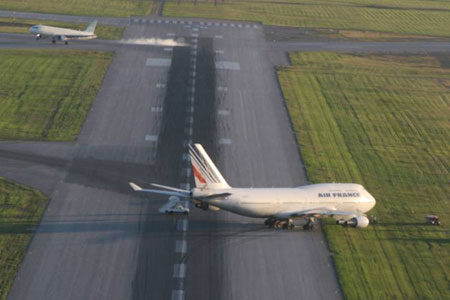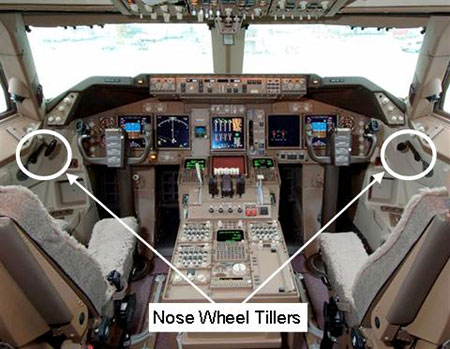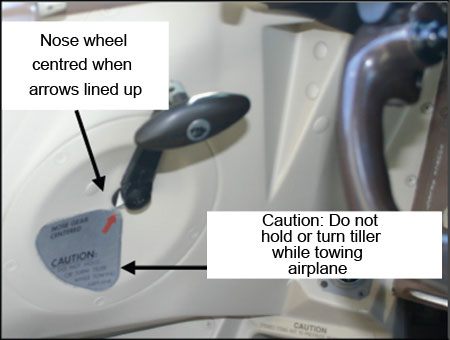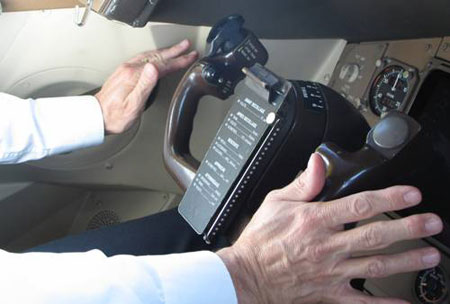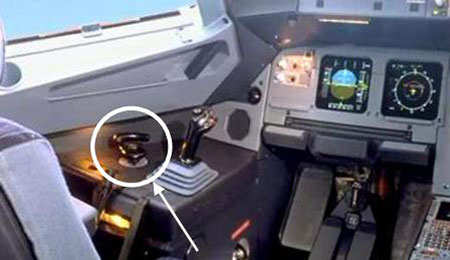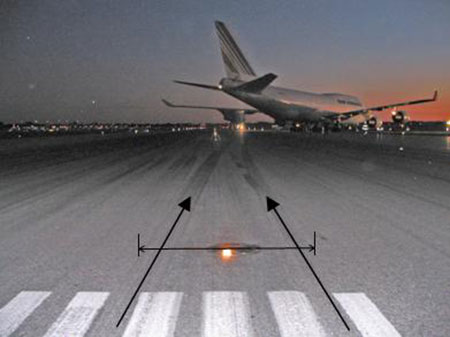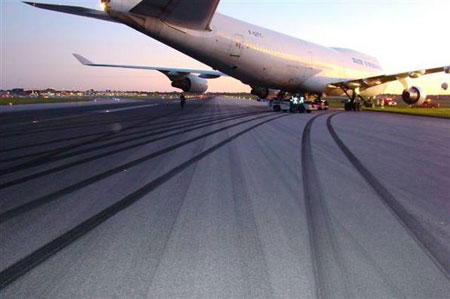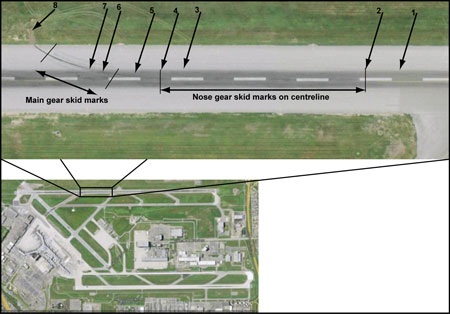Runway Excursion
Air France
Boeing 747-428 F-GITC
Montréal/Pierre Elliott Trudeau International Airport, Quebec
The Transportation Safety Board of Canada (TSB) investigated this occurrence for the purpose of advancing transportation safety. It is not the function of the Board to assign fault or determine civil or criminal liability. This report is not created for use in the context of legal, disciplinary or other proceedings. See Ownership and use of content. Masculine pronouns and position titles may be used to signify all genders to comply with the Canadian Transportation Accident Investigation and Safety Board Act (S.C. 1989, c. 3).
Summary
The Air France Boeing 747-428 aircraft (registration F-GITC, serial number 25344) departed Paris Charles de Gaulle International Airport, France at 1456 Coordinated Universal Time (UTC) as AFR346 on a scheduled flight to Montréal/Pierre Elliott Trudeau International Airport with 491 passengers and 18 crew members on board. The aircraft landed on Runway 24R at 2145 UTC. During the rollout, the aircraft veered to the right and the crew attempted to stop the turn while applying maximum braking. The aircraft stopped with the nose wheel landing gear 26 feet past the right edge of the runway, while the main landing gear remained on the runway. There were no injuries and the passengers disembarked using passenger transfer vehicles. The aircraft was not damaged and a post-flight inspection revealed no system malfunction.
Other Factual Information
Meteorological Information
The weather at the time of landing was reported as a sky with a few scattered clouds at 24 000 feet above ground level (agl), visibility 30 statute miles, and the winds from 290°M at 5 knots.Footnote 1 There are no indications that the weather conditions played a role in this incident.
Aerodrome Information
Runway 24R is 11 000 feet long and 200 feet wide, asphalt/concrete, and aligned along 238°M. Runway inspections performed that day did not reveal any irregularity that would have affected the landing. Furthermore, the runway surface was dry at the time the occurrence aircraft landed.
Land and Hold Short Operations (LAHSO) were in effect at the airport. LAHSO allow for simultaneous takeoffs and landings when a landing aircraft is able, and is specifically instructed by the controller, to hold-short of the intersecting runway/taxiway or designated hold-short point.Footnote 2 If landing clearance does not contain a hold short instruction as part of the clearance, then LAHSO are not in effect. LAHSO were not used for the occurrence landing; the entire runway length was available.
Crew Information
The flight crew was certified and qualified for the flight in accordance with existing regulations. In the days preceding the incident, the pilot-in-command and the first officer had two and six days of rest, respectively. The crew had been on duty for approximately nine hours at the time of the occurrence.
The captain had over 10 000 hours of total flying time. During the past 18 years of his current employment, he flew as a first officer for two years on the Boeing 737 (B737) and then for 12 years on the Boeing 747-400 (B744).Footnote 3 He was then upgraded to captain on the Airbus 320 (A320) and spent four years flying that aircraft before returning to the B744 as captain. The transition training included ten line training flights, followed by a satisfactory line check that was completed on 29 June 2008. Following his release as a captain on the B744, he performed 18 flights prior to the event flight. The event landing was his 10th landing at the controls as pilot flying (PF).
The first officer had approximately 6000 hours of total flying time. During the past 10 years of his current employment, he spent four years on the B737 and six years as first officer on the B744.
History of the Flight
The flight departed Paris Charles de Gaulle International Airport (LFPG), France at 1456.Footnote 4 The departure, enroute, descent, and arrival phases of the flight were uneventful and a straight-in approach to Runway 24R at Montréal/Pierre Elliott Trudeau International Airport (CYUL) was performed in visual meteorological conditions (VMC) with light winds. At 2144, the aircraft crossed the threshold stabilized in a flaps 30 configuration with the ground spoilers armed and the autobrake system selected to position three in accordance with Air France's standard operating procedures (SOPs). The aircraft touched down within the touchdown zone of the runway, the ground spoilers automatically extended, and the thrust reversers were selected. The longitudinal deceleration was constant and the aircraft heading remained within 1° of the runway heading with small rudder inputs. Idle reverse thrust was selected at 80 knots. At approximately 65 knots, the captain (as the PF) placed his hand on the nose wheel tiller, which initiated a right turn that was stopped and corrected with momentary left rudder input. The aircraft then continued on the runway centreline with a slight tiller deflection forward (i.e. nose wheels turned towards the right).
At approximately 45 knots, as the thrust reversers were stowed and the autobrake disengaged, the aircraft veered to the right. A combination of forward nose wheel tiller and full left rudder inputs were used in an attempt to stop the turn. However, the rate of turn increased rapidly. Maximum brake pressure was then applied and the aircraft came to a complete stop at 2148 on a heading of 277°M, with the nose wheels 26 feet off the right side of the runway surface (see Photo 1).
The crew advised the tower controller that the aircraft had departed the runway surface. The inboard engines were shut down, the auxiliary power unit (APU) was started, and the remaining engines shut down at 2149. The captain initiated the alert phaseFootnote 5 by instructing the cabin crew, via the passenger announcement (PA) system, to take their positions and be prepared for a possible evacuation in accordance with Air France's Manuel Sécurité-Sauvetage Systèmes, Généralités (MSS.GEN 07.35.02).
The aircraft rescue and fire fighting (ARFF) vehicles arrived at the aircraft within two minutes of the crash alarm being triggered. Contact was established with the flight crew to confirm the fuel quantity and the number of people on board as well as to verify if medical assistance was required. The wheel brake temperatures were verified and the aircraft was declared safe to be approached by ARFF personnel. The captain then indicated the end of the alert phase to the cabin crew by using the PA system to inform the passengers that the situation was under control. The passenger transport vehicles were requested by the crew at 2152 and arrived approximately 30 minutes later.
Post-Flight Activities
Work commenced around the aircraft at approximately 2220 to prepare for the eventual tow to the ramp. Heavy equipment was manoeuvred around the aircraft and metal plates were placed behind the nose wheels, thereby covering the nose wheel tracks in the grass. This work was performed without prior consultation with the TSB investigators. Several parties involved were unsure of the obligation to protect the occurrence site, as well as the requirement to preserve evidence following a reportable aviation incident.
Aéroports de Montréal (ADM) is responsible for the measures taken when an accident or incident occurs at CYUL. The emergency response plan (ERP) is used as a management tool of emergency measures to establish the guidelines, directives, procedures, and defines the roles and responsibilities of the principal responding agencies. The ERP manualFootnote 6 in use at the time referred only to aircraft accidents and did not include provisions for dealing with reportable aviation incidents as defined by TSB regulations.
Transport Canada (TC) publishes guidance within the Aeronautical Information Manual (AIM)Footnote 7 stating that "no person shall displace, move, or interfere with an aircraft involved in an accident". However, in the event of a reportable incident, the English version of the AIM does not specifically include any provision for the protection of the aircraft and the occurrence site.
When the TSB investigators arrived on site, all the passengers and crew had disembarked from the aircraft. The aircraft was surrounded by personnel and equipment manoeuvring around the site.
Aircraft Information
The aircraft was certified, equipped, and maintained in accordance with existing regulations and approved procedures. There was no evidence found of any airframe failure or system malfunction during the flight. Post-occurrence maintenance activity on the aircraft did not find any anomaly that would have affected the directional control of the aircraft, such as the nose wheel steering, brakes, engines, thrust reversers, spoilers, and speed brakes.
Nose Wheel Steering
A hydraulically powered nose wheel steering is controlled by a tiller for each pilot to provide the primary low-speed steering of the aircraft on the ground (see Photo 2). A tiller movement of 150° clockwise will turn the nose wheels to the maximum steering angle of 70° to the right.Footnote 8 A pointer on the tiller indicates the position relative to the neutral/centred position. A caution label is also located near the pointer, advising personnel not to hold or turn the tiller while towing the airplane (see Photo 3).Footnote 9
The rudder pedals can be used to turn the nose wheels up to 7° in either direction and are used to maintain directional control during the landing rollout down to taxi speeds. Normal taxi speed is approximately 20 knots, while allowing up to 30 knots on long straight taxiways, depending on weight and taxi distance.Footnote 10 According to the B744 Flight Crew Training Manual, the nose wheel steering tiller should not be used until reaching taxi speed.Footnote 11 The tiller inputs override rudder pedal inputs to the nose wheel steering.
The rudder pedals also deflect the rudder control surfaces, which are effective at speeds above approximately 60 knots. Therefore, during the landing rollout above 60 knots, the aerodynamic forces on the rudder control surfaces can override the tiller nose wheel turn commands and induce a skid of the deflected nose wheels.
Boeing 744 Nose Wheel Tiller
The design of the B744 nose wheel steering tiller originated in the late 1960s. The nose wheel steering controls required mechanical advantage while keeping the lever length to a minimum. The design considerations proposed a swivel handle to facilitate handgrip and to avoid breaking of the wrist during operation. The limited sweep clearance available for a horizontal tiller required the tiller to be placed off axis and in the vertical plane.
The vertical position of the tiller requires a fore-aft movement to turn the aircraft on the ground. A forward movement of the left tiller initiates a right turn and an aft movement initiates a left turn. The tiller on the right hand side works in the opposite direction; a forward movement initiates a left turn and an aft movement initiates a right turn. Several other aircraft tiller systems operate on a horizontal plane using a left-right movement to turn the aircraft left and right. The use of a horizontal plane as opposed to a vertical plane provides additional movement compatibility.Footnote 12 Transitioning from the right to left seat on the B744, or from a horizontal to vertical tiller design, increases the risk of negative transfer, which may lead to habit pattern interference, particularly when faced with time-critical situations.Footnote 13 Prior to the occurrence, in the history of the B744 there have been no reported cases of loss of control on the ground related to the position and movement of the nose wheel tiller.
Although a slight forward pressure on the control column is recommended during the take-off roll to increase the nose wheel adherence to the surface of the runway, there are no recommendations for this increase in pressure on the nose wheel during the landing rollout under normal conditions. However, during the initial part of the landing rollout of the occurrence flight, the control column was deflected forward (nose down) by the PF, resulting in an increased weight on the nose wheel.
The forward displacement of the pilot's arm when pushing the control column to a near full forward position is equivalent to a forward movement of 50 to 60° of the tiller (see Photo 4), resulting in a 25 to 30° nose wheel deflection to the right.
Airbus 320 Nose Wheel Steering
The aircraft previously flown by the captain, an A320, was equipped with nose wheel tillers located at knee height for both pilots (see Photo 5). The tillers operate on a horizontal plane with a left-right movement to turn the aircraft on the ground. The usual handling of either tiller is to lower the arm, grasp the top of the handle, and move the tiller by moving the wrist. The position of the nose wheel tiller on the A320 aircraft is lower and further outboard in relation to the tiller on the B744.
Autobrake
The autobrake system provides five levels of aircraft deceleration rates for landing. Brake application begins when all thrust levers are in the closed position (idle), the ground mode is sensed, and the wheels have spun up. To maintain the selected deceleration rate, autobrake pressure is reduced as thrust reversers and spoilers contribute to the total deceleration. The symmetrical braking of the four main landing gear assemblies provides directional stability, resulting in a resistance to heading changes during the deceleration. The system provides braking to a complete stop or until it is disarmed. Air France recommends using autobrake setting three for all normal landings.Footnote 14 Autobrake setting three was selected by the crew for landing and was disengaged during the rollout at 45 knots using manual brake pressure, in accordance with company SOPs.
Thrust Reversers
Each engine is equipped with a pneumatically actuated fan air thrust reverser that is powered by bleed air from the respective engine. When the aircraft is on the ground and the forward thrust levers are in the closed position, the thrust reversers are deployed by raising the reverse thrust levers to the idle detent. When the thrust reversers are fully deployed, the thrust reverser levers can then be raised up to full reverse thrust. Reverse thrust is normally maintained until the airspeed approaches 60 knots, and then reverse thrust should be reduced to reach idle reverse by taxi speed. The thrust reversers were used in compliance with Air France SOPs.
Speed Brakes and Ground Spoilers
On the ground, the speed brake lever can be moved to control the 12 individual flight and ground spoiler panels to their full deflection. The system can also be armed for automatic deployment upon landing. On the event flight, the speed brakes were in the armed position for the landing and extended normally during the initial rollout.
Cockpit Voice Recorder
The cockpit voice recorder (CVR) was a solid-state Honeywell model SSCVR, part number 980-6022-001 and serial number CVR120-04850, which records two hours of audio. Boeing offers an optional system that automatically removes power to the CVR five minutes after engine shutdown.Footnote 15 On the incident aircraft, this capability was not installed, nor is there a regulatory requirement for its installation. To protect critical CVR data in the aftermath of an occurrence, the CVR circuit breaker can be pulled to deactivate the CVR, once it is safe to do so.
In this occurrence the circuit breaker was not pulled, which resulted in the first 51 minutes of audio following the incident to be overwritten. The CVR stopped recording approximately 171 minutes after the incident.
According to Air France Généralités Opérations (GEN.OPS)Footnote 16 manual, this occurrence is classified as a serious incident.Footnote 17 GEN.OPS section 6 gives the captain the option of preserving the CVR if he feels it is necessary for further analysis. However, the checklist in section 8 requires the CVR circuit breaker to be pulled in accordance with the Techniques d'utilisation (TU) manual.Footnote 18 During the post-flight activities following the event, the crew did not consult the TU manual and were unable to locate the circuit breaker.
Quick Access Recorder
The quick access recorder (QAR) was a Penny + Giles data recorder with part number D51434-1 and serial number 1041/08/92. The QAR does not record nose wheel steering tiller position or nose wheel deflection. No additional parameters recorded on the QAR were useful to the investigation.
Digital Flight Data Recorder
The digital flight data recorder (DFDR) was a solid-state Honeywell model SSFDR, part number 980-4700-042 and serial number SSFDR-09535. DFDR plots were produced for the entire flight up until approximately four minutes after the aircraft came to a stop, when all engines were shut down. Nose wheel tiller movement and nose wheel deflection are not recorded by the DFDR.
Image (Video) Recording
TSB Safety Recommendation A03-08 called for regulatory authorities to "develop harmonized requirements to fit aircraft with image recording systems that would include imaging within the cockpit" to "provide investigators with a reliable and objective means of expeditiously determining what happened". This recommendation supported similar United States (U.S.) National Transportation Safety Board (NTSB) recommendations issued in 2000 (i.e., A-00-30 and A-00-31) calling for the implementation of image recording systems in aircraft operated under 14 Code of Federal Regulations Part 121, 125, or 131. In its response, TC supported the TSB's recommendation; however, harmonized requirements were not developed. The U.S. Federal Aviation Administration (FAA) supported the NTSB recommendations and produced a "proof of concept," which may ultimately result in FAA rulemaking.
The response to this recommendation remains assessed by the TSB as Satisfactory Intent.
Runway Tire Skid Marks
The nose wheel skid marks commence in a straight line on the runway centreline and remain on the centreline markings and centreline lighting over a distance of approximately 600 feet. The skid marks then move towards the right edge of the runway, resulting in a total skid distance of approximately 1160 feet (see Photo 6). The nose wheels came to rest 26 feet past the right edge of the runway.
The main landing gear tire skid marks commence approximately 800 feet after the nose wheels began to skid, and continued for approximately 210 feet. The right main landing gear tires stopped 9 feet from the edge of the runway (see Photo 7).
Longitudinal g data from the DFDR corresponds to the measured skid marks on the runway surface and help to establish the timeline. In addition, lateral g DFDR information at the time the skid marks begin, combined with a slight right turn and momentary rudder deflection to the left; all confirm the synchronization of DFDR data and the runway skid marks. The synchronization of DFDR data and runways skid marks produces the following sequence of events (See Figure 1):
| # | Time | Speed (k) | Event |
|---|---|---|---|
| 1 | 21:45:12 | 66 | Control column reaches neutral from forward deflection, lateral g to the right followed by a short left rudder correction |
| 2 | 21:45:13 | 63 | Nose wheel skid marks on the runway centreline begin as a result of an approximate 25° nosewheel deflection |
| 3 | 21:45:19 | 47 | Reversers stowed |
| 4 | 21:45:20 | 45 | Autobrakes disengaged, nose wheel skid marks leave runway centreline, aircraft heading increases |
| 5 | 21:45:21 | 44 | Rudder reaches full left position and tiller deflection is increased |
| 6 | 21:45:23 | 43 | Max. brakes are applied |
| 7 | 21:45:24 | 40 | Main gear skid marks appear on the runway |
| 8 | 21:45:30 | 0 | Aircraft stops |
Analysis
The approach and landing were conducted in calm VMC weather, with all the aircraft systems functioning as designed. The PF was experienced, qualified, and had recently completed the transition training back to the B744 from the A320. Nothing indicates that fatigue could have played a role in the occurrence. Therefore, the analysis will focus on the actions of the crew during the landing rollout and the environment in which those actions took place.
The initial crew actions during the landing rollout were in compliance with the company SOPs. In addition, the PF held the control column forward of neutral to keep pressure on the nose wheel. A few seconds after the thrust reversers were brought to idle reverse, the control column was released. One second later, at a speed of approximately 65 knots, the PF voluntarily placed his hand on the tiller, possibly in anticipation of using the next available runway exit, which was at approximately 1300 feet on the left. A careful analysis of the nose wheel skid mark widths along the runway centreline (see Photo 6) confirm that the tiller was initially pushed and maintained forward approximately 50° corresponding to a right nose wheel deflection of approximately 25°. At that speed, the rudder control surface was still effective and the PF successfully used left rudder to overcome the right turn initiated by the tiller input. However, this caused the loss of adherence of the nose wheels with the runway surface, inducing the skid. Additionally, the autobrake provided directional stability by applying even braking on all main gears; therefore, rudder deflection was no longer required for the aircraft to remain on the runway centreline and the PF removed the left rudder correction. However, the nose wheel skid marks straight down the runway centreline over the next 600 feet confirm that the PF maintained the forward (right) tiller input throughout the deceleration and did not notice the presence of a forward tiller input.
Although the initial nose wheel tiller input can not be explained, the arm's angular position corresponds to an equivalent angular position it had when it was on the control column one second earlier. It is possible that the PF inadvertently pushed the tiller forward thinking it was the control column.
As the aircraft speed decreased, the thrust reversers were stowed and the autobrake was disengaged. The loss of directional stability provided by the autobrake combined with the nose wheels regaining lateral adherence with the runway surface at the lower speed of 45 knots caused the aircraft to veer to the right. In reaction to this right turn, the PF applied full left rudder and intended to apply left nose wheel tiller command. Instead, the PF pushed the tiller further forward and down, increasing nose wheel deflection to the right. From his previous experience as a first officer in the right seat of the B744, this forward and down input (on the right hand tiller) would have produced a left nose wheel deflection. However, it could also be the result of an unintentional attempt to apply an A320 tiller input, which would have been located lower and to the left in comparison to the B744 tiller position in the cockpit.
Because nose wheel steering inputs override rudder steering inputs at low speed, the left rudder deflection was ineffective in stopping the turn. However, had the tiller been released, it would have returned to the centre/neutral position and the turn would have stopped.
Boeing documentation advises against use of the tiller above taxi speed. Although placing the hand on the tiller is not formally discouraged in existing procedures, placing a hand on a control at a speed where it should not be utilized increases the risk of it being activated or used inadvertently.
There was no pressing reason to turn the aircraft at the point where the skid marks appear because no taxiways were within close proximity on either side of the runway. Furthermore, LAHSO were not used for the landing; therefore, the full length of the runway was available. This indicates that the initial tiller application was an involuntary movement. When the aircraft later veered to the right, the PF was presented with a time critical situation. With his hand already on top of the tiller, the PF was likely influenced by habit recall from his previous experience on the A320 or his right seat experience on the B744. While rapidly trying to execute a left tiller input, he inadvertently pushed the already deflected tiller further down, resulting in an increased right turn, causing the aircraft to depart the runway surface.
Site Protection and Preservation of Evidence
ADM personnel initiated work around the aircraft without prior consultation with the TSB investigators in order to re-open the runway as soon as possible. Because the emergency response plan used at the time of the incident did not include provisions for dealing with reportable incidents, it is likely that ADM personnel did not realize TSB approval was required.
TSB regulations require the preservation and protection of any evidence relevant to a reportable incident. However, the guidance for reportable incidents found in the AIM does not include a provision for the protection of aircraft or the occurrence site. This inconsistency can contribute to the uncertainty as to the obligation to protect the occurrence site, as well as the requirement to preserve evidence following a reportable incident.
Cockpit Voice Recorder
The voice recordings of the landing incident were overwritten, indicating that electrical power to the CVR remained on for a significant period of time after the event. Because the automatic shutdown feature was not installed on the event aircraft, the CVR had to be manually deactivated by pulling the appropriate circuit breaker. Unfortunately, after the aircraft was stopped, the CVR circuit breaker was not located and pulled, and all conversations relevant to the occurrence were lost.
Chapter 11 of the Air France Généralités Opérations (GEN.OPS) manual, section 6, implies that the preservation of the CVR recordings is at the discretion of the captain, while the checklist in section 8 requires deactivation of the CVR following a serious incident or accident. This inconsistency greatly increases the chance that critical CVR data will be lost despite the regulatory obligation to preserve evidence following a reportable incident.
This loss of CVR data is not unique to Air France; it occurs frequently when aircraft are involved in reportable incidents. This hampers investigators' ability to obtain a timely, complete, and accurate understanding of the event.
Image (Video) Recording
The aircraft was not equipped with an image (video) recording device. As a result, critical information may have been lost which would have proven helpful in determining the events that led up to the occurrence.
The following TSB laboratory report was completed:
- LP 113/2008 – DFDR/QAR/CVR Analysis.
This report is available from the Transportation Safety Board of Canada upon request.
Findings
Findings as to causes and contributing factors
- The placement of the hand on the tiller at high speed resulted in an unintentional tiller deflection, causing the nose wheels to skid when rudder was used to counter the turn.
- With his left hand already placed on the tiller, the pilot flying (PF) inadvertently pushed the deflected tiller further forward and down, resulting in an increased right turn, causing the aircraft to veer to the right and depart the runway surface.
- The cockpit voice recorder (CVR) was not deactivated after the event. As a result, cockpit conversations were overwritten and critical information that could assist TSB investigators was lost.
- Failing to protect an occurrence site and preserve evidence jeopardizes a TSB investigator's ability to carry out an investigation.
Other Finding
- The use of image (video) recording devices that include imaging within the cockpit would enhance transportation safety by providing investigators with a reliable and objective means of expeditiously determining what happened during an occurrence.
Safety action
Action Taken
Air France
Air France distributed an internal memo to all B744 crews describing the event and reviewing the recommended use of the tiller.
Sections 6 and 8 of Chapter 11 of the Généralités Opérations (GEN.OPS) manual have been amended to correct the inconsistency regarding the preservation of cockpit voice recorder (CVR) recordings following a serious incident.
Aéroports de Montréal
The Aéroports de Montréal emergency response plan manual has been revised to define incidents and add references to incidents throughout. Therefore, the protection of occurrence sites and the Aéroports de Montréal's coordination with the TSB has been clarified.
This report concludes the Transportation Safety Board's investigation into this occurrence. Consequently, the Board authorized the release of this report on .
